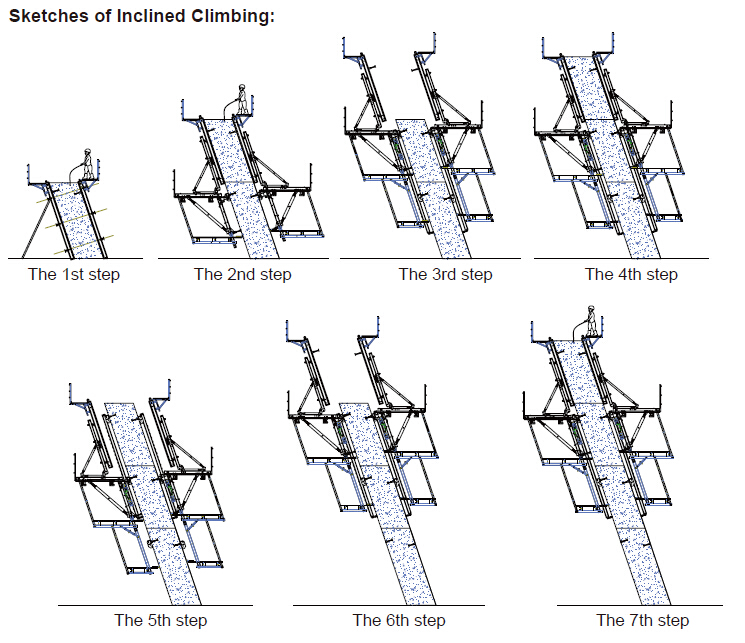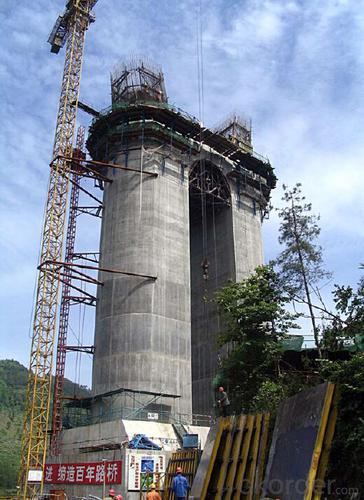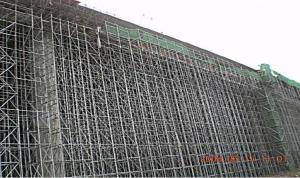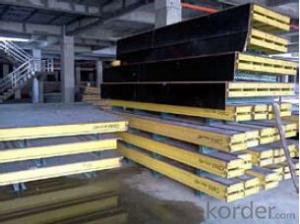Auto Climbing Bracket ACB100&ACB50 for formwork and scaffolding system
- Loading Port:
- Tianjin
- Payment Terms:
- TT OR LC
- Min Order Qty:
- 50 m²
- Supply Capability:
- 1000 m²/month
OKorder Service Pledge
OKorder Financial Service
You Might Also Like
Auto-climbing Bracket ACB100 & ACB50
The power of the auto-climbing formwork is the hydraulic system, which includes the oil cylinder
and two commutators. The commutators can control the climbing of climbing rail and the bracket.
The steel rail and the bracket can inter-climbing, so the whole system will climb up steadily.
Cranes are not needed during the construction. It’s easy to operate, highly efficient and safe. It’s
the best choice for the construction of high buildings and bridges.
There are mainly two types of standard auto-climbing brackets, ACB-50 and ACB-100, the figure
means the push power of cylinder with unit of KN.
Characteristics:
◆ Perfect load bearing anchor system
Anchor system is the most important supporting part. The system is made of five parts shown
below. Thereinto, tensile bolt, V-climbing cone and washer can be taken out for reusing after the
concrete pouring finished.There are two kinds of anchor systems,A & B. A is matched with single
anchor shoe and B is matched with double anchor shoe.
◆ Crane-independent
Crane-independent forming, striking and climbing speeds up the work procedures on the
construction site and also makes them independent of each other. This means the planned
sequences can be maintained along with guaranteeing high productivity levels. The crane can
therefore be used for other tasks.
Hydraulic system is mainly made of two commutators,
oil cylinder and power distribution system.The
commutators can control the climbing of climbing rail
and bracket.
◆ High bearing capacity and safe
The stable working platforms are able to carry large loads, e.g. the storage of reinforcing steel
for the next climbing section. Generously-sized working platforms, the well thought-out design for
handling very high wind loads and the patented control function of the climbing mechanism are
some of the special details contained within the comprehensive safety concept.
◆ Platforms adjusted to suit the angle of inclination
The horizontal working areas thus created provide safe and comfortable conditions for
reinforcement work, shuttering and striking, concreting and finishing.
◆ The ACB formwork system can climb not only vertically but also slantways, the largest angle is
18 degrees.
◆ The system can climb up wholly or separately. The climbing process is steady, synchronous
and safe.
◆ The bracket will not fall to the ground until the construction is finished, the field will be saved
and the impacting breakage will be reduced (especially the panel).
◆ The system will furnish omnidirectional platform, the construction organizations don’t need to
set up additional operation platform.
◆ The error of structure construction is small and easy to correct.
◆ The climbing speed is fast, the construction course will be quickened.
◆ The formwork can climb itself and cleaning work can be done in the same situs , the used times
of tower crane will be greatly reduced.

- Q: What are the different quality control measures for steel formwork construction?
- Steel formwork construction commonly implements several quality control measures to guarantee the quality and integrity of the final product. Some of these measures include: 1. Inspection of materials: Prior to commencing construction, thorough inspections are conducted on all steel formwork materials to ensure they meet the necessary specifications and standards. This entails checking for defects, such as cracks or deformations, and verifying the quality of the steel used. 2. Welding inspections: Welding is often required to join different components of steel formwork structures. Regular inspections are crucial to ensure that all welded joints are executed properly and meet the required strength and quality standards. This involves checking for proper penetration, weld size, and alignment, as well as conducting non-destructive testing if necessary. 3. Dimensional checks: Accurate dimensions are vital for the proper assembly and functionality of steel formwork structures. Throughout the construction process, regular dimensional checks are conducted to ensure that all components are fabricated to the correct specifications. This includes verifying the lengths, widths, and thicknesses of plates, beams, and other structural elements, as well as checking for proper alignment and positioning. 4. Surface finish inspection: The surface finish of steel formwork components significantly affects their performance and durability. Regular inspections are carried out to ensure that all surfaces are free from defects such as roughness, cracks, corrosion, or any other imperfections that could compromise the structure's integrity. 5. Load testing: Load testing is a crucial quality control measure for steel formwork construction. It involves subjecting the formwork structures to a predetermined load to ensure they can withstand the expected forces during use. Load testing can be performed using various methods, including static or dynamic load tests, and helps ensure the structural stability and safety of the formwork. 6. Documentation and record keeping: Proper documentation and record keeping of all quality control measures performed during steel formwork construction are essential. This includes recording the results of inspections, tests, and any corrective actions taken. Documentation facilitates traceability, provides a reference for future inspections, and ensures compliance with relevant standards and regulations. By implementing these quality control measures, steel formwork construction companies can guarantee that their structures meet the required standards, are safe and durable, and provide reliable support during the concrete pouring process.
- Q: How does steel formwork contribute to the overall speed of construction?
- There are several ways in which steel formwork speeds up construction. Firstly, its high strength and durability allow it to handle the pressure and weight of wet concrete. This means that construction teams can pour concrete into the formwork and continue with the next steps without waiting for it to fully cure. As a result, the overall construction time is significantly reduced. Furthermore, steel formwork is highly reusable, unlike traditional timber formwork which needs frequent replacement. This means that construction crews can move from one section to another without constantly preparing new formwork. This saves both time and resources, further enhancing the speed of construction. In addition, steel formwork offers better precision and accuracy compared to other types. Its rigid structure ensures that concrete is poured and shaped exactly as intended, reducing the need for costly adjustments. This precision allows construction teams to proceed with subsequent tasks without delay. Moreover, steel formwork is lightweight and easy to handle, making it quick to assemble and dismantle. This ease of use allows construction crews to set up the formwork system swiftly, reducing installation time. Similarly, when the concrete has cured, the steel formwork can be easily disassembled and moved to the next site, further speeding up the construction process. In conclusion, the strength, durability, and reusability of steel formwork contribute to the overall speed of construction. Its precision and ease of handling also play a significant role in accelerating the process. With these advantages, construction teams can complete projects more efficiently, saving time and reducing costs.
- Q: What are the typical safety precautions when working with steel formwork?
- To ensure the safety of workers and prevent accidents, it is important to adhere to various safety measures when working with steel formwork. These measures include: 1. Personal Protective Equipment (PPE): Workers must wear the appropriate PPE, such as hard hats, safety goggles, gloves, and steel-toed boots, to protect themselves from falling objects, flying debris, and foot injuries. 2. Training: Workers should receive proper training on the safe use of steel formwork and be aware of the potential hazards associated with the equipment. They should also be educated on proper lifting techniques and the handling of heavy steel components. 3. Inspection: Before commencing work, a thorough inspection of the steel formwork should be conducted to identify any defects, damage, or weak points. Any faulty or worn-out components must be replaced immediately to prevent accidents or collapses. 4. Secure Anchoring: It is crucial to securely anchor the steel formwork to prevent shifting or collapsing during construction activities. Sufficient bracing and supports should be in place to ensure stability and avoid unexpected movements. 5. Proper Handling and Lifting Techniques: Workers should employ appropriate lifting techniques when handling heavy steel components to prevent strains, back injuries, or accidents. The use of mechanical aids, such as cranes, hoists, or forklifts, should be considered to minimize the risks associated with manual handling. 6. Fall Protection: When working at heights, appropriate fall protection measures, such as guardrails, safety harnesses, or safety nets, should be utilized to prevent falls and injuries. 7. Communication and Signage: Clear communication among workers is vital to avoid accidents. Adequate signage should be displayed to indicate the presence of steel formwork, potential hazards, and restricted areas. 8. Regular Maintenance: Regular maintenance and inspections of the steel formwork should be carried out to ensure its structural integrity. Any identified issues should be promptly addressed to prevent accidents or failures. 9. Emergency Preparedness: Workers should be familiar with the emergency procedures in place, including the location of first aid kits, fire extinguishers, and evacuation routes. Regular drills and training sessions should be conducted to ensure workers are prepared for potential emergencies. By adhering to these safety precautions, the risk of accidents, injuries, and property damage when working with steel formwork can be significantly reduced, thereby creating a safer working environment for all involved.
- Q: How is steel formwork constructed?
- Steel formwork is constructed by assembling steel panels, beams, and props to create a sturdy framework. The panels are usually made of steel sheets with stiffeners and are connected together using various techniques such as bolts or clamps. The beams are placed horizontally and act as the primary support for the formwork system. Props are used to support the beams and distribute the load evenly. The steel formwork system is then adjusted and aligned to the desired shape and size, ensuring proper reinforcement and concrete pouring.
- Q: What types of concrete structures can be built using steel formwork?
- Steel formwork is a versatile construction tool that can be used to build various types of concrete structures. Some of the common structures that can be built using steel formwork include: 1. Walls: Steel formwork can be used to construct both retaining walls and load-bearing walls. It provides the necessary support to hold the concrete in place until it sets and gains its strength. Steel formwork allows for the construction of walls with different shapes and sizes, including straight, curved, or inclined walls. 2. Columns: Steel formwork is ideal for constructing columns of different heights and diameters. It provides a strong and stable framework to hold the concrete in place while it cures. Steel formwork can be easily adjusted to accommodate various column dimensions, making it suitable for both small and large-scale construction projects. 3. Beams and Slabs: Steel formwork can also be used to construct beams and slabs. Beams are horizontal structural members that provide support to the structure above, while slabs are the horizontal elements that form the floors or roofs of a building. Steel formwork allows for the construction of beams and slabs with different shapes and sizes, including rectangular, circular, or even curved configurations. 4. Bridges and Tunnels: Steel formwork is commonly used in the construction of bridges and tunnels. It enables the creation of complex structural elements with high precision and accuracy. Steel formwork systems can be easily transported and assembled on-site, making them an efficient choice for bridge and tunnel construction projects. 5. Staircases: Steel formwork can be used to build staircases with different configurations, including straight flights, spiral stairs, or helical stairs. It provides the necessary support to create the desired shape and geometry of the staircase. Steel formwork ensures the structural integrity of the staircase while the concrete sets and hardens. Overall, steel formwork offers a flexible and durable solution for constructing a wide range of concrete structures. Its adaptability, strength, and ease of use make it an ideal choice for various construction projects, from residential buildings to large-scale infrastructure developments.
- Q: How does steel formwork handle concrete shrinkage and cracking?
- Steel formwork is a versatile and durable option when it comes to dealing with concrete shrinkage and cracking. Its design ensures support and stability during the pouring and curing process, effectively minimizing the negative effects of shrinkage and cracking. One of the main benefits of steel formwork is its capacity to withstand the pressure exerted by shrinking concrete. Steel is a resilient material that can resist the forces generated by the drying and hardening of the concrete. As a result, the formwork remains intact and does not deform or collapse under the weight of the shrinking concrete. Moreover, steel formwork often incorporates expansion joints or other flexible components that can accommodate the movement caused by shrinkage and cracking. These joints allow the formwork to expand and contract in sync with the concrete, reducing stress on the structure and minimizing the risk of cracks. Additionally, steel formwork can be easily reinforced or supplemented with additional support elements, like braces or tie rods, to further enhance its ability to handle concrete shrinkage and cracking. These reinforcements ensure the forces exerted by the shrinking concrete are evenly distributed across the formwork, decreasing the likelihood of localized cracking or structural failure. In summary, steel formwork is a reliable and robust solution for effectively managing concrete shrinkage and cracking. Its strength, flexibility, and capacity for reinforcement make it an ideal choice for construction projects where minimizing the impact of these issues is of utmost importance.
- Q: Is steel formwork suitable for all types of construction projects?
- No, steel formwork may not be suitable for all types of construction projects. It is commonly used in large-scale projects that require repetitive use of formwork, such as high-rise buildings or bridges. However, for smaller or more intricate projects, other types of formwork materials like wood or plastic may be more appropriate. The choice of formwork depends on factors such as project size, complexity, budget, and specific requirements.
- Q: How does steel formwork affect the overall aesthetics of a structure?
- Steel formwork does not have a direct impact on the overall aesthetics of a structure as it is a temporary structure used for shaping and supporting concrete during construction. However, steel formwork can indirectly affect aesthetics by allowing for precise and smooth finishes, resulting in a more visually appealing final product. Additionally, steel formwork's strength and durability ensure structural integrity, which is essential for maintaining the long-term aesthetics of the structure.
- Q: How does steel formwork handle different concrete finishing techniques?
- Steel formwork offers a wide range of possibilities for concrete finishing techniques due to its high versatility. It possesses great strength and durability, enabling it to withstand the pressure and forces exerted throughout various finishing procedures. When aiming for a smooth finish, steel formwork provides a solid and stable surface that facilitates easy pouring and leveling of the concrete. Its rigidity guarantees that the concrete remains in position and does not sag or deform during the finishing process. Consequently, the concrete can be smoothly troweled, resulting in a polished and uniform surface. Steel formwork is also suitable for textured finishes. It can be customized with different patterns and textures to create unique and decorative concrete surfaces. By utilizing specially designed steel formwork, such as those with corrugated or embossed patterns, the concrete can be poured to replicate these designs, resulting in visually appealing textured finishes. Furthermore, steel formwork is capable of accommodating exposed aggregate finishes. This technique involves removing the top layer of concrete to reveal the underlying aggregate stones, thus creating a decorative effect. Steel formwork can be designed with removable panels or inserts that allow the concrete to be poured in a way that exposes the desired amount of aggregate. After the concrete has cured, these removable panels can be easily taken off, revealing the desired exposed aggregate finish. Moreover, steel formwork is suitable for stamped concrete finishes. Stamped concrete involves imprinting patterns or textures onto the concrete surface using specialized stamps. Steel formwork provides a solid foundation for these stamps to be pressed onto, ensuring accurate and consistent imprints. The rigidity of steel formwork prevents the concrete from shifting or deforming during the stamping process, resulting in precise and high-quality stamped finishes. Overall, steel formwork is highly compatible with various concrete finishing techniques. Its strength, stability, and versatility make it an ideal choice for handling different finishing processes, allowing for the creation of smooth, textured, exposed aggregate, and stamped concrete finishes with precision and ease.
- Q: What are the components of a steel formwork system?
- A sturdy and efficient construction formwork is typically created by a steel formwork system, which is composed of several components. These components include: 1. Steel Panels: The primary element of a steel formwork system is high-quality steel panels, available in various sizes and shapes. These panels are designed to withstand the pressure exerted by the concrete during pouring. 2. Steel Walers and Soldiers: To enhance strength and stability, steel walers connect the steel panels horizontally, while soldiers support the steel panels vertically, preventing bulging or deformation under the weight of the concrete. 3. Tie Rods: Threaded rods called tie rods are used to secure the steel panels and walers together. These rods pass through holes in the panels and are secured with nuts and washers. They help maintain the formwork system's structural integrity and resist outward pressure from the wet concrete. 4. Formwork Accessories: To improve efficiency and ease of use, several accessories are used in conjunction with steel formwork systems. These accessories include formwork clamps, pins, cones, and wedges. They ensure alignment and secure the formwork components, preventing any movement during concrete pouring. 5. Formwork Braces: Steel diagonal members known as formwork braces provide additional support and stability to the formwork system. They are installed at regular intervals to prevent sagging or buckling of the formwork. 6. Formwork Joints: Formwork joints connect different sections of the steel formwork system. Depending on the construction project's requirements, these joints can be temporary or permanent. Temporary joints are typically used for modular formwork systems, allowing for easy assembly and disassembly. In summary, a steel formwork system is a durable and robust solution for constructing concrete structures. Its components work together to create a strong and reliable formwork that can withstand the pressures exerted during concrete pouring.
Send your message to us
Auto Climbing Bracket ACB100&ACB50 for formwork and scaffolding system
- Loading Port:
- Tianjin
- Payment Terms:
- TT OR LC
- Min Order Qty:
- 50 m²
- Supply Capability:
- 1000 m²/month
OKorder Service Pledge
OKorder Financial Service
Similar products
Hot products
Hot Searches


















